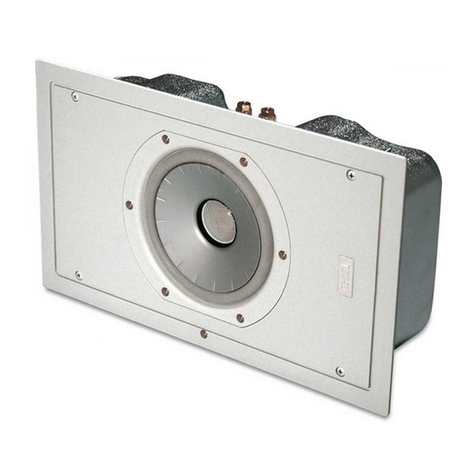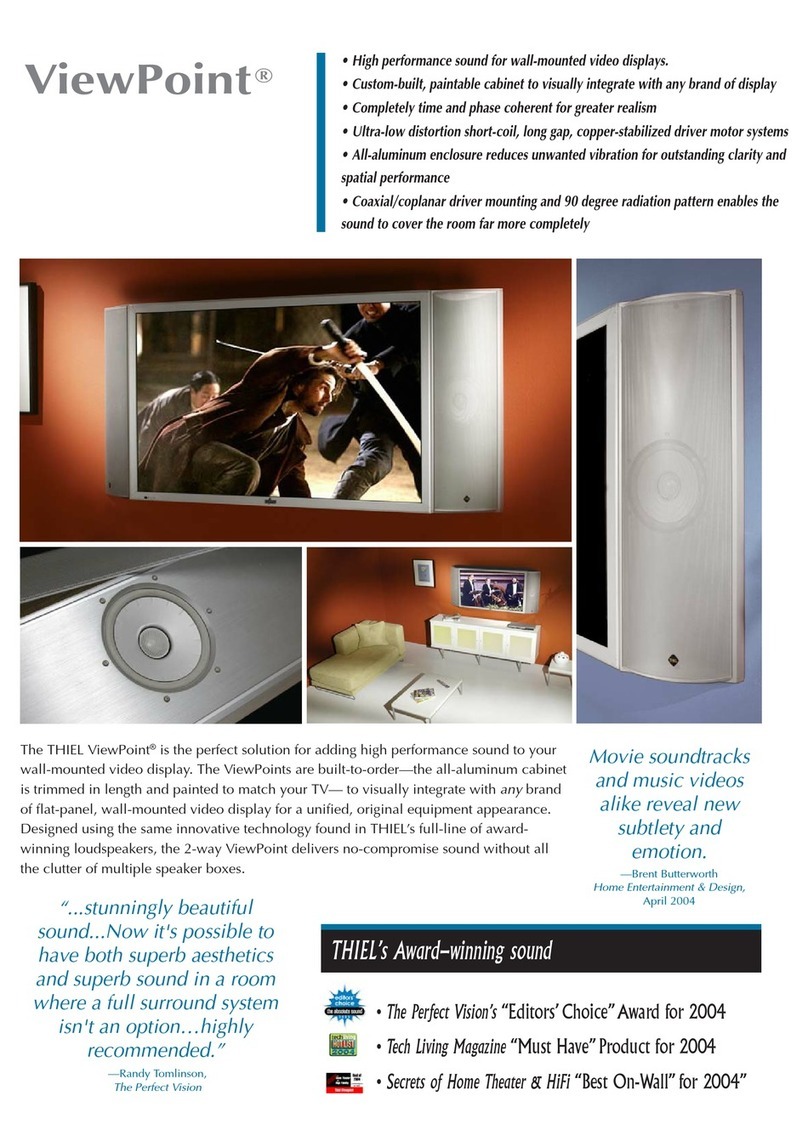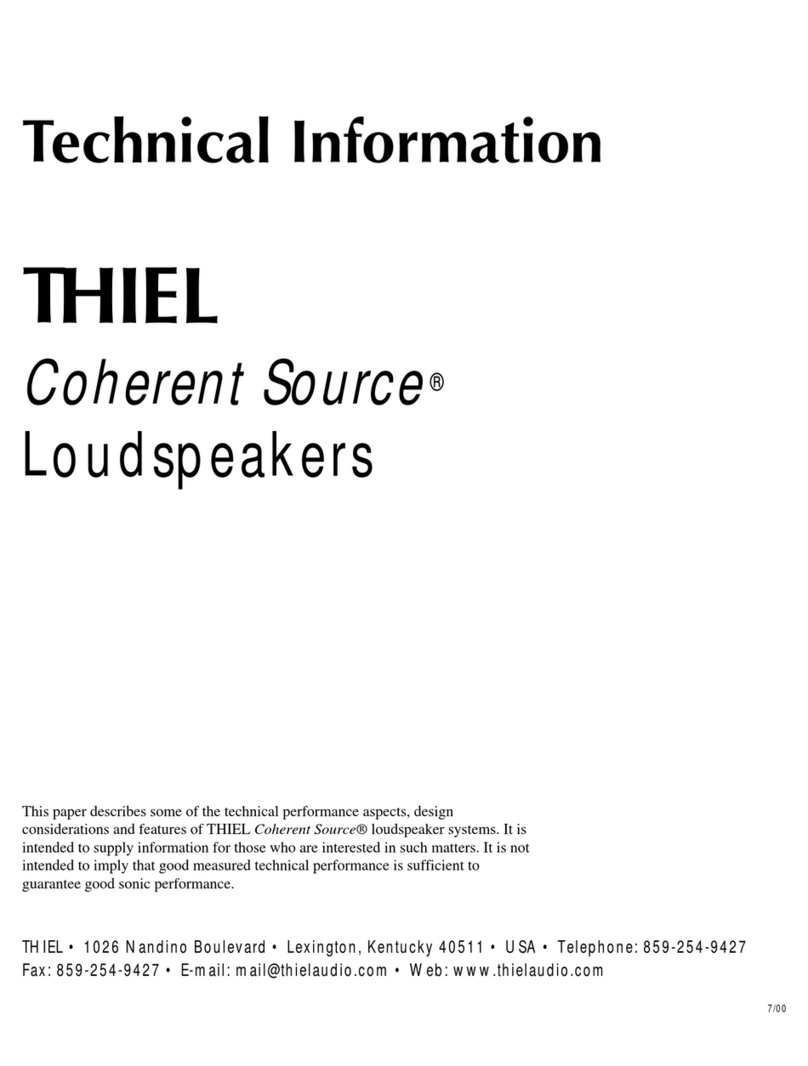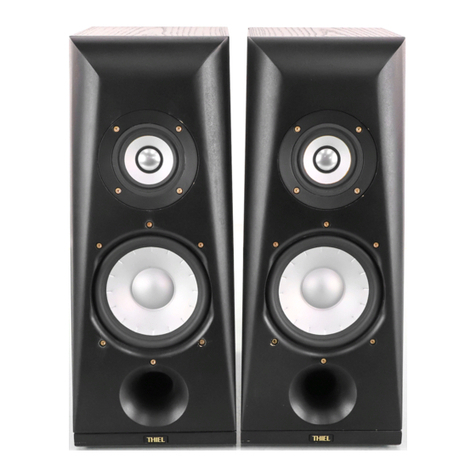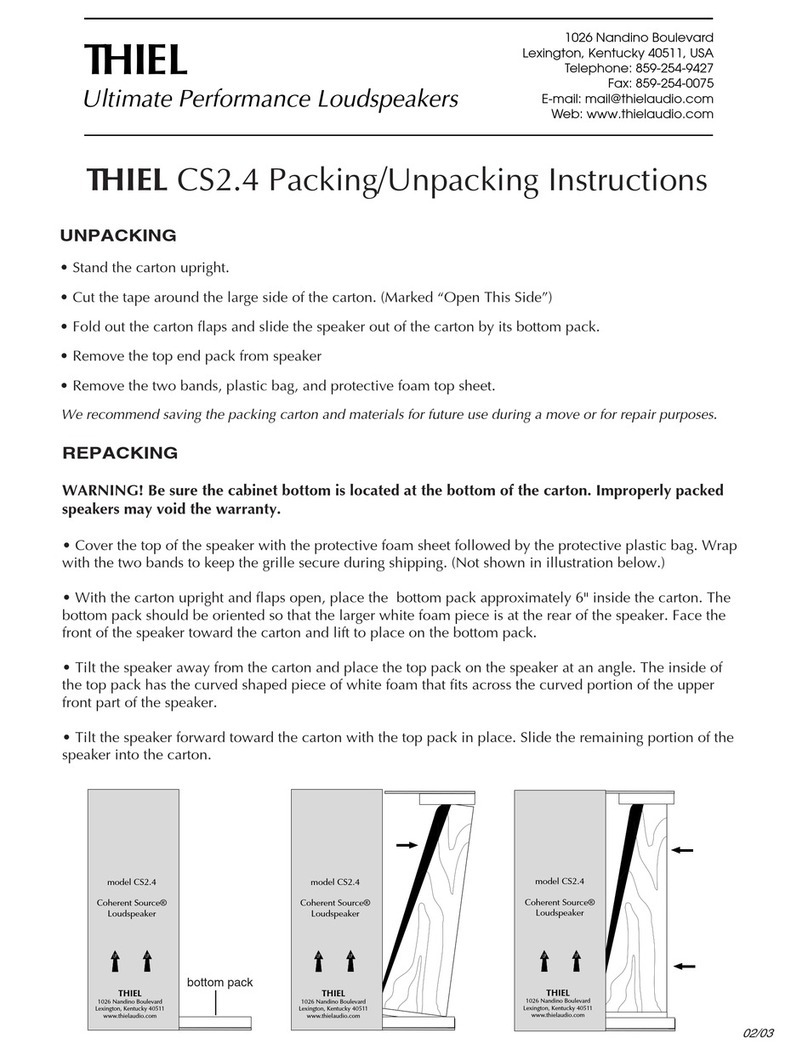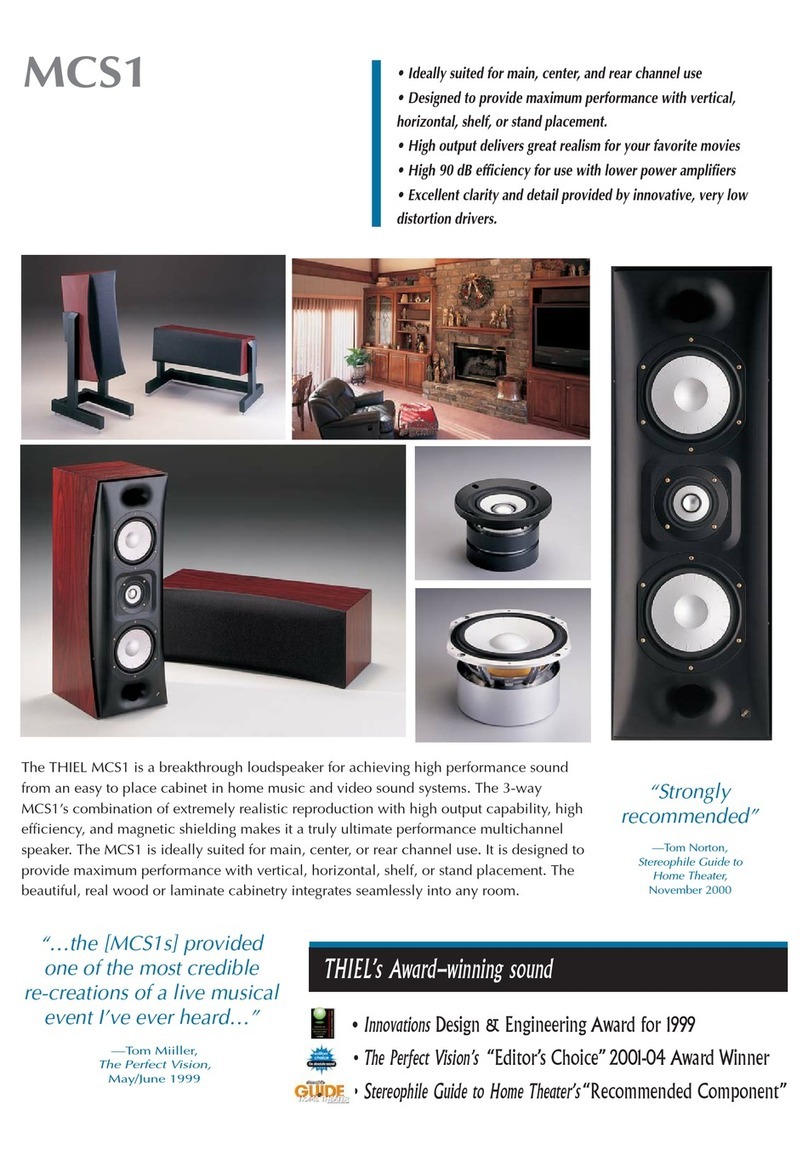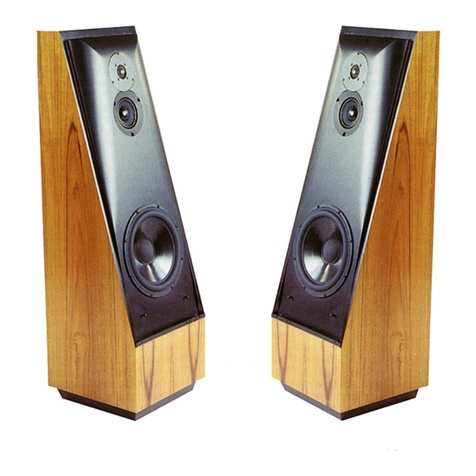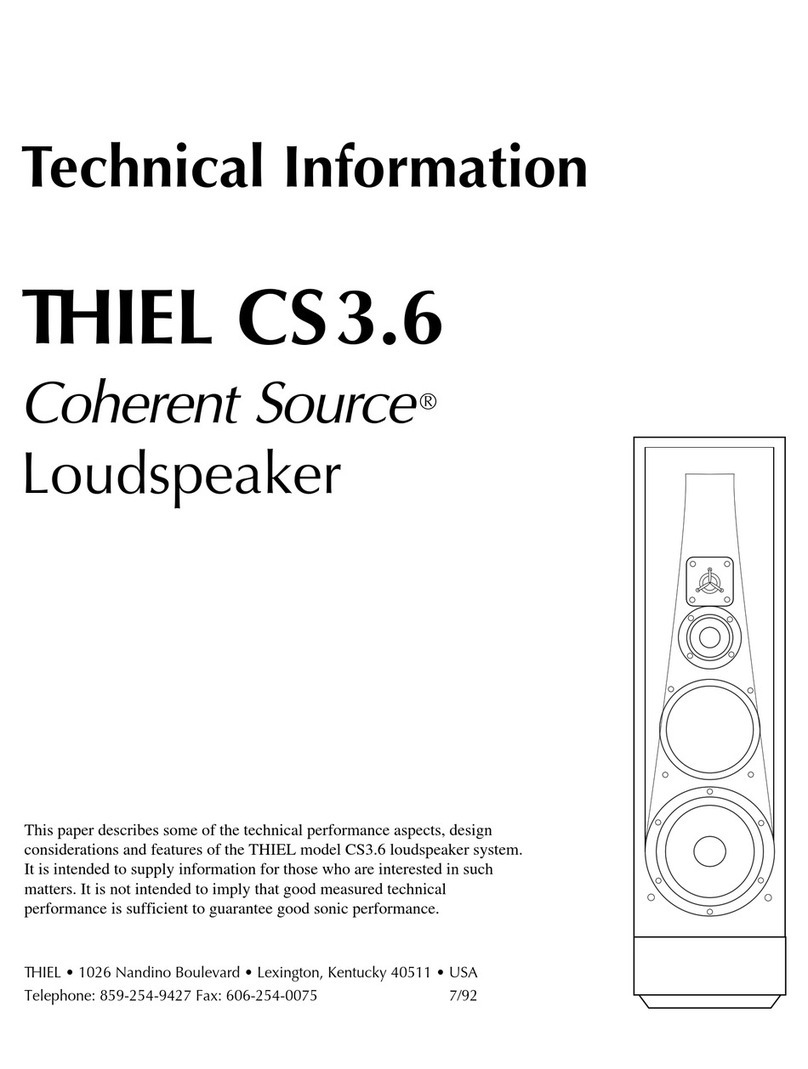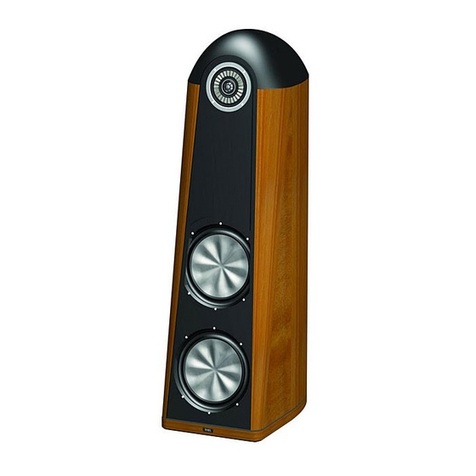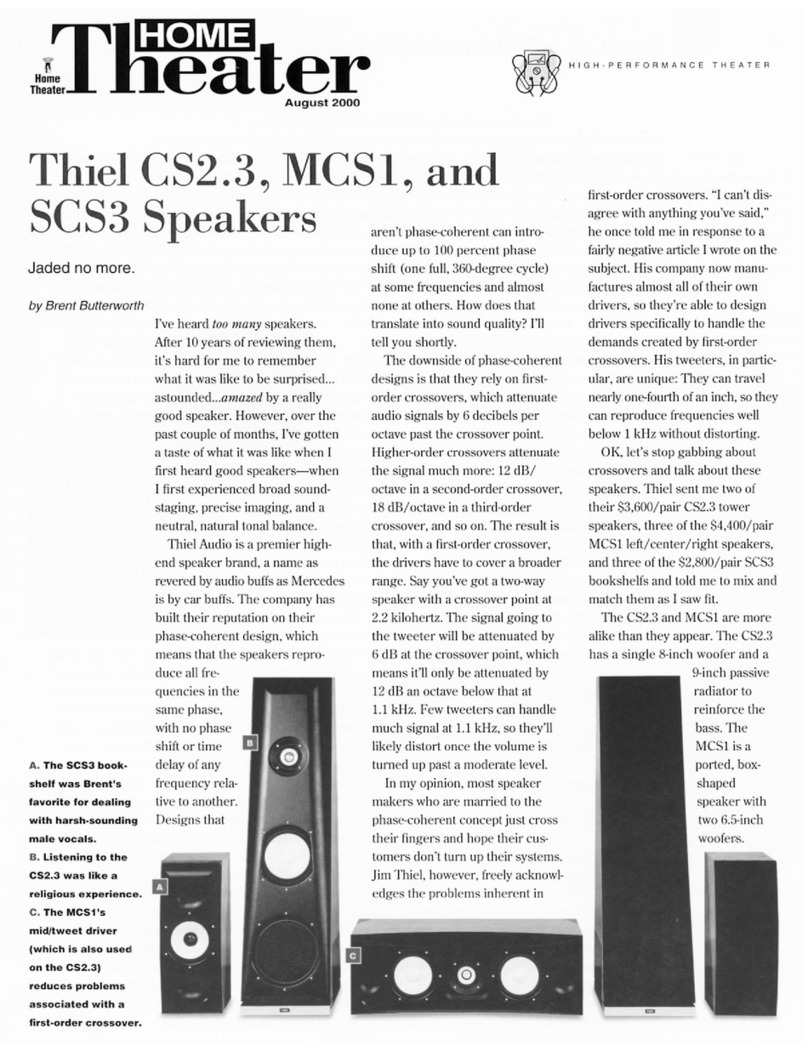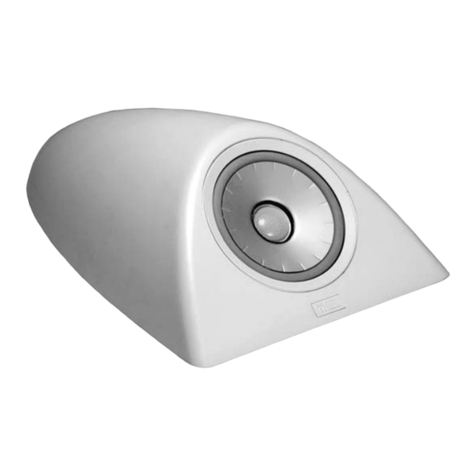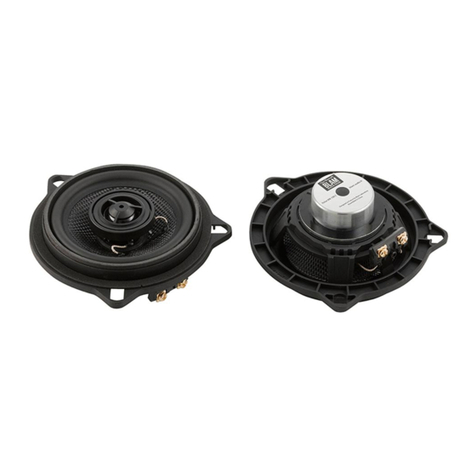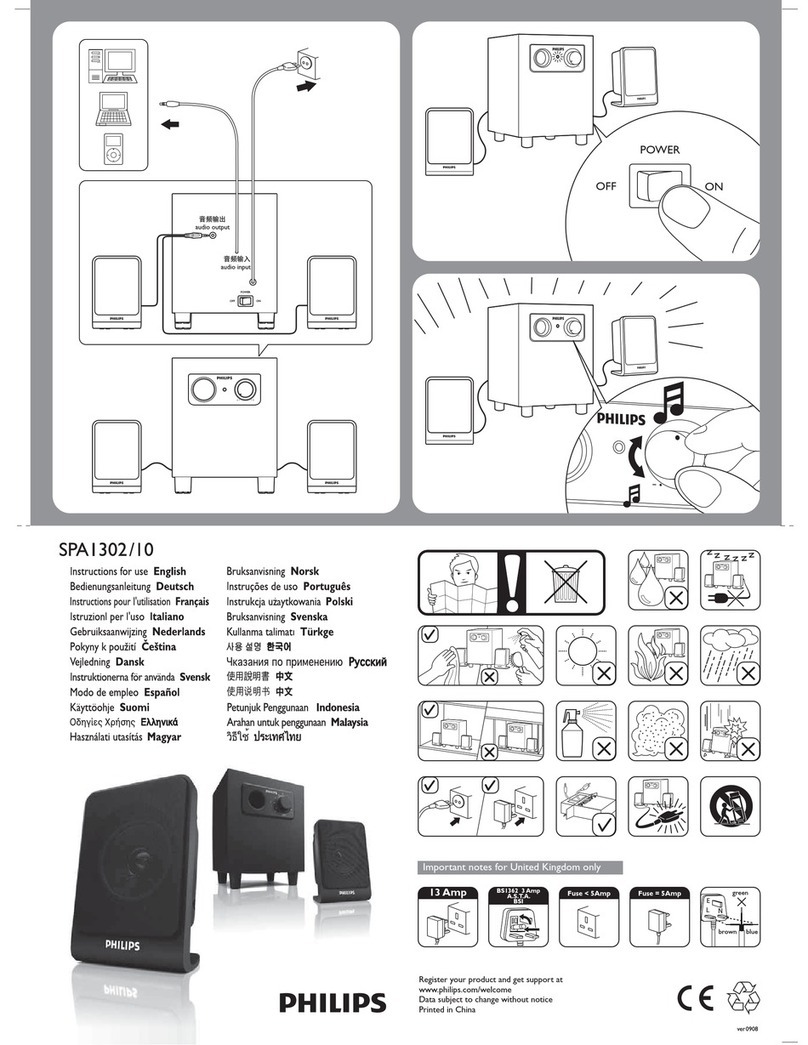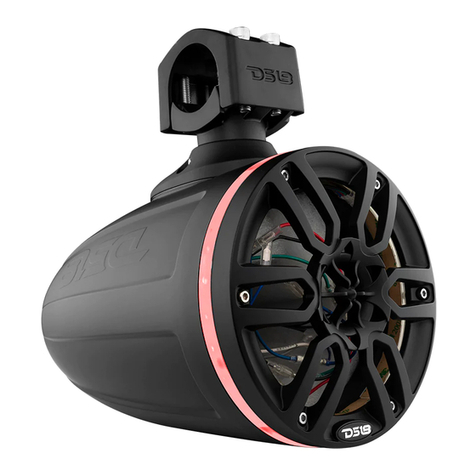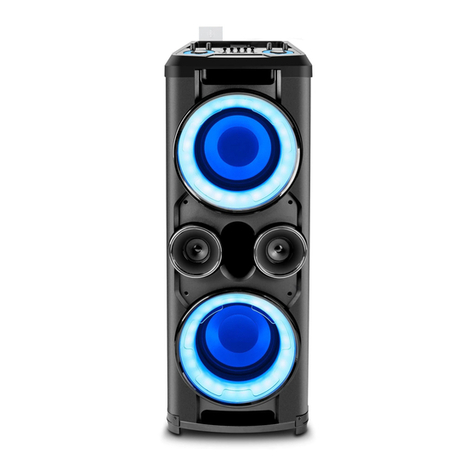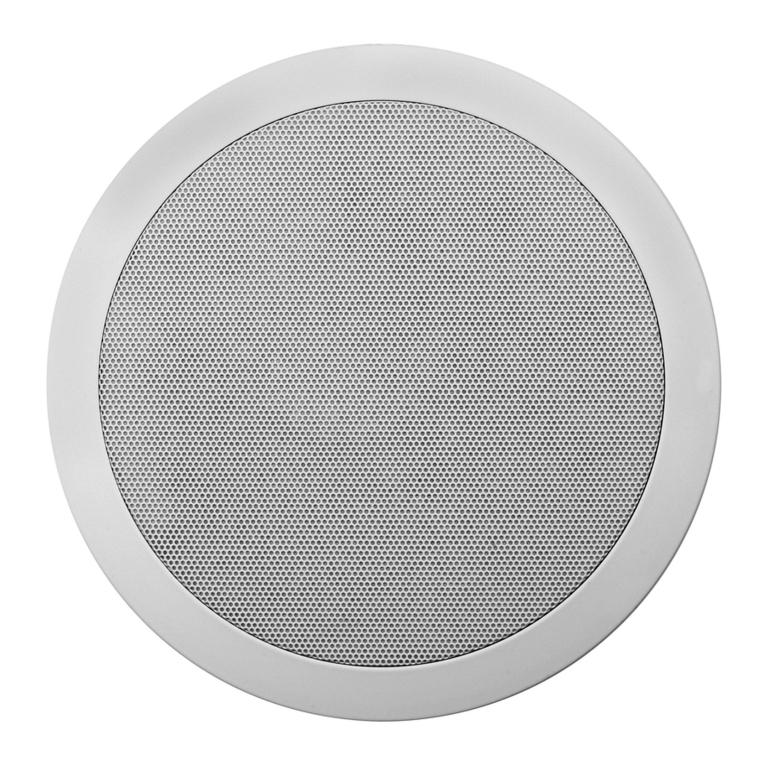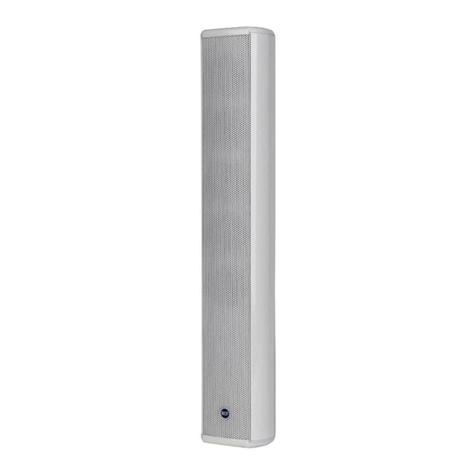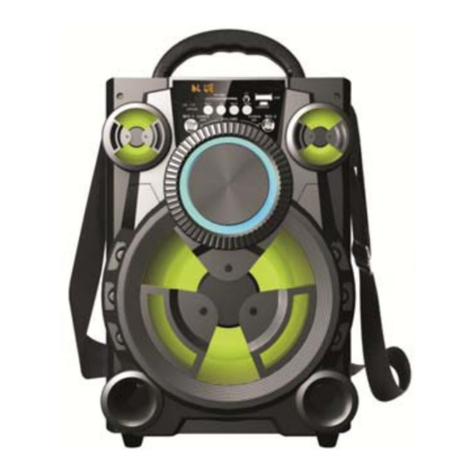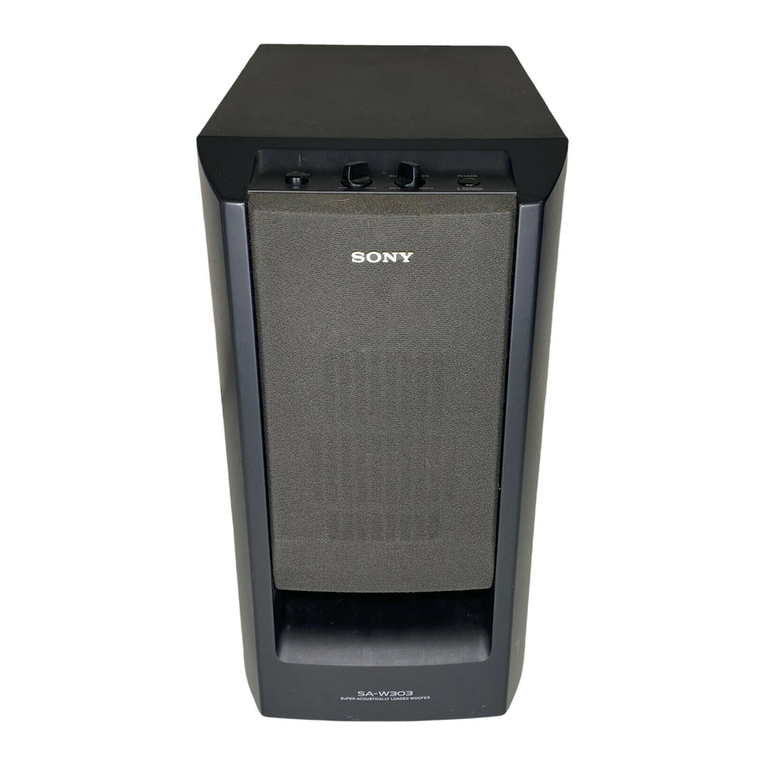Thiel CS1.5 User manual

ELECTRONICALLY REPRINTED FROM APRIL/MAY 2002 Issue 135

Reality check—$2,390
is a lot of money. This
may not seem so in
the rarefied world of
high-end audio, but
to most folks on the street, $2,390 for
a pair of loudspeakers represents a
monumental investment for a “luxu-
ry” item.
Within that context,
what should we make of
the new $2,390 Thiel
CS1.6 loudspeaker? The
answer is as simple as it is
profound—Thiel has
established a new bench-
mark in speaker perform-
ance that substantially
reduces the entry price to
ne plus ultra performance.
It’s worth $2,390, even to
music-lovers not looking
for that last scintilla of
performance.
As a replacement to
the venerable CS1.5,
which was a market
favorite during its nine-
year run, the CS1.6 is not
just an update. Designer
Jim Thiel has redefined
what is possible for
roughly two grand.
Before the CS1.6, I
found the “elbow”
where increasing price
in loudspeakers bought
only small improvements was
somewhere in the $4,000-$5,000
range. That is, you could pay more
than $5,000, but the improvements
came in rapidly diminishing propor-
tions; a great $5,000 speaker (think
Aerial 10T) achieves most of what a
$60,000 design does (incremental
improvements are, of course, musi-
cally significant and financially justi-
fiable—but this is the point that sep-
arates the average music lover from
the hardcore enthusiast).
The Thiel CS1.6 reduces the
price-performance
elbow to,
well, $2,390. Excluding the bottom
octave, which it will not do, this new
Thiel possesses tonal, dynamic, spa-
tial, and transient resolution compa-
rable in most ways to the world’s best
speakers. And the critter is wicked
sexy looking, sort of a Mini-Me ver-
sion of Thiel’s flagship CS7.2.
Once upon an audio adventure, I
named the CS1.5 the Best Value in
audio. Thus, when Thiel’s press
release heralded the CS1.6, my
interest was piqued and my expecta-
tions were raised. Most notable was
the sensitivity specification: 90dB @
2.8V/1m. Jim Thiel’s designs have
almost always been of a lower sensi-
tivity (the CS1.5 was an 86dB
design), partly owing to his first-
order crossover designs.
This review is a first look because
we got the speakers two weeks
beyond the normal deadline, barely
in time (though Thiel had logged 50
hours of break-in on them before
shipping) for some meaningful listen-
ing. As with any of the great prod-
ucts, it took no time whatsoever to
recognize that this new Thiel was
extraordinary. And while I am confi-
dent in my observations, further lis-
tening with a wider range of associ-
ated equipment will reveal more of
the speaker’s character.
The New Design
Thiel’s primary technical
objective here was to over-
come the sensitivity limitation
inherent in first-order cross-
overs without abandoning his well-
established crossover approach. One
Thiel CS1.6 Loudspeaker
A New Benchmark in High-End Performance
Tom Miiller
equipment review
To subscribe to the absolute sound, call 888-475-5991 (US), 760-745-2809 (outside US) or visit www.theabsolutesound.com. $42 for six issues in the US;
$45 Canada, $75 outside North America. Posted by permission from Absolute Multimedia, Inc. All rights reserved. Any unauthorized duplication of this article is strictly prohibited.

way to achieve higher sensitivity is to
reduce the amount of moving mass
in the diaphragm, which unavoid-
ably reduces diaphragm stiffness and
increases distortion, especially at
louder levels.
In an effort to overcome these
penalties, Thiel designed an innova-
tive voice coil that was dramatically
wider (three inches) than convention-
al voice coils in 6.5-inch woofers.
Thiel found that the wider coil’s
energy was being spread more wide-
ly and evenly across the diaphragm,
raising sensitivity and increasing
stiffness. Because the voice coil was
so wide, the magnet had to be
installed inside it instead of in the
conventional exterior location.
Consequently, Thiel used a higher
quality neodymium magnet that
would fit inside the voice coil. And
with the magnet installed within the
voice coil, the speaker is self-shield-
ing, meaning that it can be used close
to CRT-based video display devices.
Although Thiel ended up not sig-
nificantly reducing the moving mass
of the diaphragm, he achieved the
desired sensitivity improvement and
pushed the first resonant mode of
the woofer up to 9kHz, well above
the crucial upper midrange. The
CS1.6 is a two-way design that cross-
es over from the woofer to the tweet-
er at 3kHz; thus, the 9kHz resonant
mode (distortion) is far above the
crossover point, significantly reduc-
ing the audibility of the distortion.
Moreover, a 9kHz resonance origi-
nating from a 6.5-inch driver has
limited dispersion, reducing its audi-
bility to anyone not sitting on axis
with the driver.
The most notable visual charac-
teristic of the CS1.6 is its long
(roughly 20 inches) vertical slotted
port. By using this arrangement with
a surrounding taper that disperses
air across a six-inch-wide area, Thiel
maintained the efficiency of the
port, with or without grille cloth.
The tweeter of the CS1.6, says
Thiel, has more in common with
its cost-no-object siblings than it
does with tweeters commonly
found in the two-grand range.
Thiel incorporated the techniques
he employs in the CS7.2 tweeter: a
short-coil/long-gap configuration
with a copper-stabilized motor sys-
tem. The result according to Thiel
is that the CS1.6 tweeter is capable
of significant excursion, meaning
that it is both lower in distortion
and capable of higher levels. Thiel
even uses a high-quality poly-
styrene-foil bypass capacitor in the
crossover, improving treble dynam-
ics and purity.
Finally, the cabinet is a substantial
upgrade over the CS1.5. The baffle is
two-inch thick MDF, permitting
Thiel to round the baffle away from
the tweeter, reducing diffraction
effects and improving spatial resolu-
tion. The rest of the cabinet is made
of one-inch thick MDF. All together,
the CS1.6 weighs 38 pounds.
Quiet Graces and
Emphatic Moments
I wish one sentence could convey
the entirety of the CS1.6’s sonic
beauty. I can’t think of one, so I’ll
start by telling you what it did for
me: It relaxed me in a way no hi-fi
has since I worked with the Audio
Artistry speakers. The CS1.6 has the
physiological restorative capabilities
of live music; it untied tension knots
and pulled at emotional strings. It
found quiet graces within the music
and brought them gently but insis-
tently to my attention. The simple
interweaving lines in the “Allegretto”
movement of Beethoven’s Symphony
No. 7 [DG 431 76802] unfolded in a
stately, inevitable progression that
drew me hypnotically from one line
to the next. Throughout this move-
ment, the CS1.6 easily kept the
instrumental groups separated tim-
brally and spatially.
Easily. That’s one word that helps
to describe the CS1.6. Everything it
does, it does easily. A key indicator of
quality is that the speaker requires
only a smidge of volume before it
becomes musically satisfying. The
CS1.6 fills out tonally at volume levels
much closer to live levels and its reso-
lution of transient information is so
penetrating, you can hear everything
at levels that won’t threaten your
hearing. Live music, as you may know,
rarely reaches 100dB at the audience.
Julian Bream’s guitar, as he per-
forms Rodrigo’s Concierto de Aranjuez
[BMG 6525-2-RG] is both lyrically
mournful in the tailing shape of
the notes and emphatic in its lead-
ing transient speed. The CS1.6 did
not soften the leading edge, and
just as quickly released that hard
transient to make way for the more
nuanced and emotional shape of
the note. This bespeaks an excep-
tional level of true dynamics, espe-
cially in the tweeter.
Intrinsic in the CS1.6’s effortless
sound is its top-to-bottom coordina-
tion. The lower frequencies are cor-
rectly placed in time relative to the
middle and treble frequencies. The
consequence is a stunning level of
intelligibility, both in instrumental
and human voices. The CS1.6 is
nearly magical in the way it presents
the female voice. Whether it was
Janis Ian [Breaking Silence; Morgan
Creek 2959-20023], Jennifer Warnes
[Famous Blue Raincoat; Classic
Compact Discs RTHCD 5052] or
Bonnie Raitt [Road Tested; Capitol
7243 8 3370-52], this speaker pre-
sented each voice with unsurpassed
clarity and body. Each voice was dis-
tinctive, as were the production val-
ues of each recording. The Ian is
soft; Warnes’ production is more pop
and slightly hard; Raitt’s live per-
formance has a trace of sibilance
that the CS1.6 neither hid nor exag-
gerated. Moreover, it easily handled
Warnes’ demanding dynamic range.
Given its excellent intelligibility,
the CS1.6 would also be adept in a
home theater (indeed, with its
short-ish stature, I’d use it as a cen-
ter channel).
Dynamics,
Tonality, Space
As I mentioned above, there is no
bottom octave. Achieving the desired
sensitivity nearly ensured this result,
and this is, after all, a two-way design.
But the bass produced by the CS1.6
(solid to 50Hz) is of the highest quali-
ty. Pitch definition and timbre resolu-
3 •THE ABSOLUTE SOUND • 135

tion are superb. But if you truly desire
that sense of hall volume and the low
lows, then you’ll need a subwoofer
(Thiel’s got a dandy). The CS1.6 cap-
tured the rolling violence of the tym-
pani in Berlioz’ “The March to the
Scaffold” [Symphonie Fantastique; Telarc
CD-80271], but it could not convey
the sheer force of the instrument, nor
could it recreate the shudder issuing
from yet another infamous Telarc
bass drum. Nevertheless, the CS1.6
has just enough bass extension and
power to be musically satisfying on
most music.
So often we scratch and claw for
the ability to play really loud. But
what we really need is a speaker that
can resolve dynamic differences into
the lowest noise floor and confident-
ly reach undistorted peaks that con-
vey a realistic range. The CS1.6 will
not rise at light speed to skull-crush-
ing levels as will the behemoths that
inhabit the $50,000 strata. And yet,
its low-level resolution is so sublime,
I never found the speaker con-
strained on peaks. Indeed, I was
tickled to hear it handle Wilhelm
Kempff ’s piano on Bach’s Choral
Preludes [DG 439 672] in a dynami-
cally credible fashion. A real piano
can fill a room with sound that no
speaker system can hope to match,
yet the CS1.6 conveyed the sensa-
tion of powerful clarity that defines
the instrument.
Jim Thiel and his designs have
been at the front of one of audio’s
most difficult debates: What is accu-
rate treble? One side maintains it is
necessary to roll off the treble to
replicate the sound of live treble.
The other camp, in which Thiel
resides, holds the position that the
speaker should be neutral, that is flat,
at all frequencies, including the tre-
ble. I have long preferred speakers
that roll off the high treble, but I’m
not sure that is technically correct.
What I have learned over the years is
that treble distortions are the most
pernicious and difficult to root out of
a system. In distorted circumstances,
flat treble response will be harder to
take than reduced response.
What I hear in the CS1.6 is a
continuation of Thiel’s adherence to
flat treble. And I also hear a signifi-
cantly cleaner presentation of that
treble. Consequently, the higher fre-
quencies integrate better and are
easier to listen to. It is still a little
strong on top, but there’s no denying
how informative the treble’s har-
monic contribution is to defining
instrumental timbre. The CS1.6
exhibits enough improvement in this
area that I’m leaning toward the side
of flat treble, especially since I’ve
heard several new-generation power
amps that radically reduce treble dis-
tortions (I’ll be getting several with
which to test this theory).
Regardless of the argument, the
CS1.6 has treble performance char-
acteristics rarely heard at any price.
When orchestral bells or chimes are
struck, the CS1.6 cleanly reproduces
the first wave and then, in the sustain-
ing decay, the sound floats through
and above the soundstage and propa-
gates throughout the room, just as it
would in the concert hall.
Finally, the CS1.6 soundstage
transcends the usual limitations of
small speakers. Probably because of
the lowered diffraction from the
rounded baffle, its expansive sound-
stage sounds much larger than the
speakers. And within that stage
resides the signature Thiel image-
focus and separation. If you want
more than this in a soundstage,
you’ll need to add the subwoofer
and go surround.
Certainly, the Thiel CS1.6 is not
a perfect loudspeaker. But its imper-
fections are more in the nature of
limitations. It won’t plumb the bot-
tom octave or scale the highest
dynamic peaks. But with its
increased sensitivity comes effortless,
natural resolution. I have not heard
a speaker anywhere near this price
that possessed such a low noise floor.
I just don’t see the point in spending
more than $2,390 if this is what you
get—unless you invest in a state-of-
the-art woofer that will elevate the
entire system into the performance
stratosphere. My advice: Buy the
CS1.6 and spend your money on the
best sources and electronics you can
afford. The Thiel CS1.6 is an
instant classic. &
MANUFACTURER INFORMATION
THIEL AUDIO
1026 Nandino Blvd.
Lexington, Kentucky 40511
Phone: (859) 254-9427
www.thielaudio.com
Price: $2,390 per pair
SPECS
Recommended power: 50–300 watts
Sensitivity: 90dB @ 2.8V/1m
Phase response: Minimum +/-10 degrees
Impedance: 4 ohms (3 ohms minimum)
Bandwidth: 48Hz–20kHz (-3dB)
Dimensions: 9 x 11.5 x 35.5 inches
Weight: 38 lbs.
ASSOCIATED EQUIPMENT
Onkyo SR-D2.0 DVD player; Theta Casanova
Processor/Preamp; Bryston 9B-ST power
amplifier; BEL The Wire and The Cable inter-
connects and speaker cable
1026 Nandino Boulevard • Lexington, Kentucky 40511 • USA
This manual suits for next models
1
Other Thiel Speakers manuals

Thiel
Thiel Coherent Source CS3.7 User manual
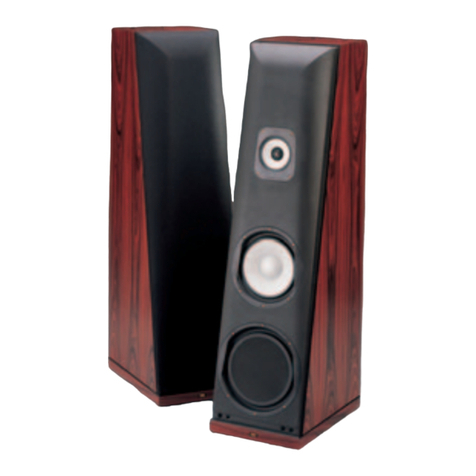
Thiel
Thiel CS6 User manual
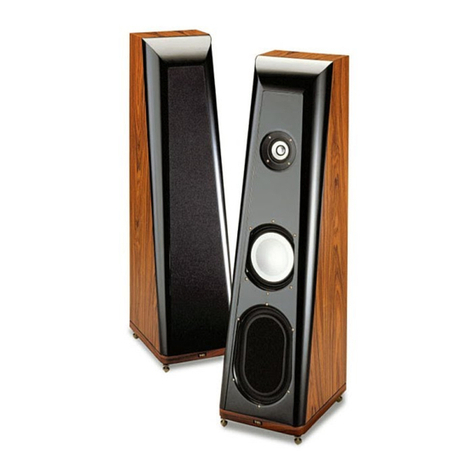
Thiel
Thiel CS2.4 User manual
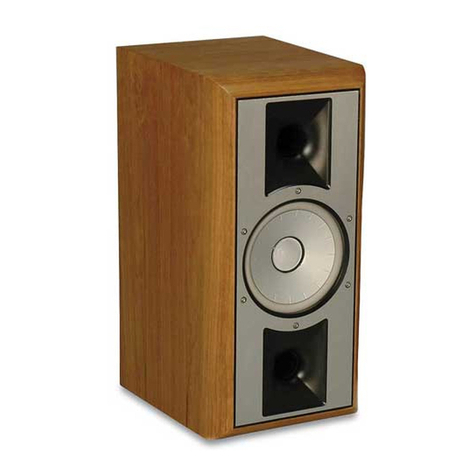
Thiel
Thiel Coherent Source SCS4 User manual

Thiel
Thiel SCS3 User manual
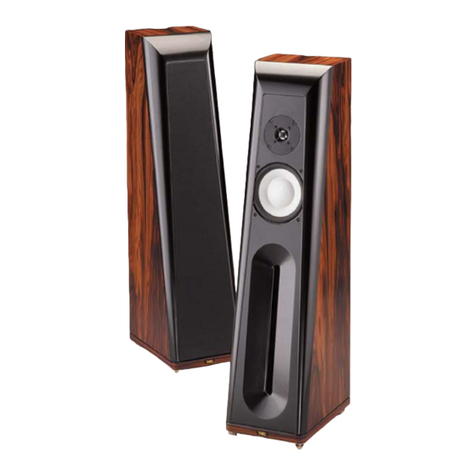
Thiel
Thiel CS1.6 User manual
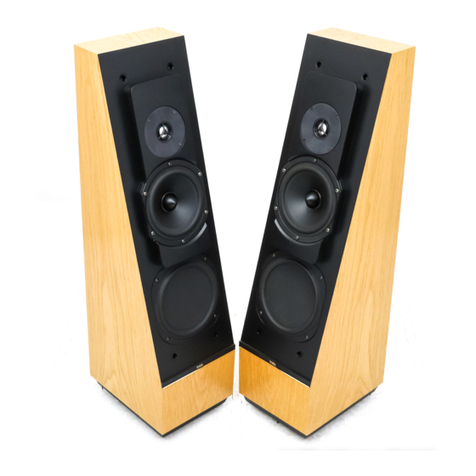
Thiel
Thiel CS1.5 User manual
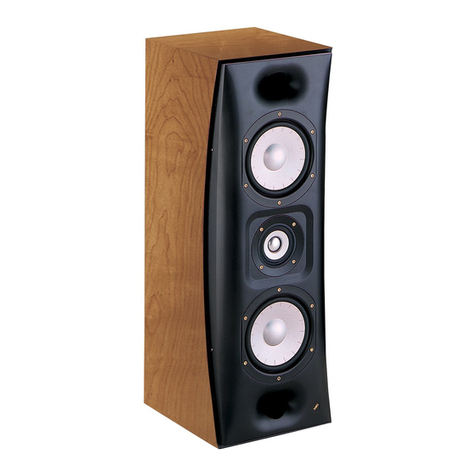
Thiel
Thiel MCS1 Manual
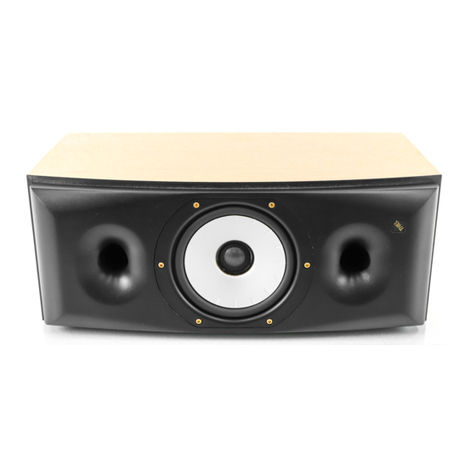
Thiel
Thiel Coherent Source SCS3 Manual

Thiel
Thiel Coherent Source CS2.7 User manual
